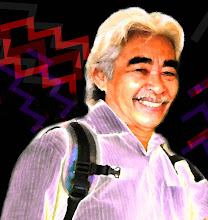 The time lapse between the two pictures above is about 60 years. It surprises me today how intact the buildings, monuments and spaces at the complex area are after such a long long time. My interest in this complex story started in Bintulu a few weeks ago when I was flipping through some old photo albums kept by my father. He was a young man in Kuching around 1948 when the above picture was taken.
The time lapse between the two pictures above is about 60 years. It surprises me today how intact the buildings, monuments and spaces at the complex area are after such a long long time. My interest in this complex story started in Bintulu a few weeks ago when I was flipping through some old photo albums kept by my father. He was a young man in Kuching around 1948 when the above picture was taken.The Court House Complex has a very long, colourful and significant story since it was developed starting in 1868 and over the years till 1924, many new additional buildings were added. During the Brooke's and then the British colonial rule, many functions of the government of the day were held here. It was the seat of government, native court, judicial court, Council Negeri meetings ( i.e. local government meetings) , public clinic and even functioned as a hospital. When Sarawak achieved independence, the complex was home to the Sarawak State Legislative Assembly meetings starting in 1963 right on till 1973.
The Clock Tower was added in 1883 to the porch at the entrance of the complex. The complex buildings are very colonial in style with massive round columns, wide verandas and balconies, brick walls and pitched roofs using 'belian' shingles. In front of the Court House Complex is a Memorial dedicated to Charles Brooke, the second white Rajah of Sarawak. The memorial was unveiled in 1924. It has a marble relief of Charles Brooke's head and above it the old crest and coat of arms of Sarawak.
Today the Old Court House Complex is being re-used as the State Tourism Complex. Tourists can easily obtain brochures,maps and many Sarawak tourism related literature here for free. Besides that it does have exhibition hall, an eating outlet and souvenir shop.
 Above is a view of the Kuching waterfront area from the Complex, showing the new Sarawak State Legislative Assembly building ( with gold coloured roof) in the far background nearing completion.
Above is a view of the Kuching waterfront area from the Complex, showing the new Sarawak State Legislative Assembly building ( with gold coloured roof) in the far background nearing completion. Part of a building block within the complex in the background is converted into an eating outlet called 'The Little Lebanon'.
Part of a building block within the complex in the background is converted into an eating outlet called 'The Little Lebanon'.There is another interesting connection with this complex story to Bintulu. It was on the 8th of September 1867 that the first ever Council Negeri meeting ( i.e. local government meeting) was held in Bintulu and presided by Charles Brooke. Thus making Bintulu the birthplace of 'modern' democratic practice in Sarawak.
Thanks to the British, democratic principles and practises were introduced early to the peoples of Sarawak.




















2 comments:
You know, I thought exactly the same as you write in your first paragraph; how little change there has been between the two pictures.
May I ask a very ignorant question; what is the official language in Malaysia? I recall from your pictures, that you drive on the left side, as the English do. And you master the English language perfectly.;)
Also, do you have democracy and do you elect a president? I am sorry that I am very ignorant in this respect.;)
I guess being a Malaysian I'm entitled to answer your queries. Our official language is Bahasa Malaysia or Malay language. It is the main medium of instruction in the national education system,from the kindegarten levels right up to university since 1974. I say'national' because in Malaysia today there are so many private universities being set up( through twinning or as foreign campus)that conduct their studies in English. Yes, Malaysians copy a lot from the British. We drive on the left side. We love the Beatles. And I used to sing "God Save the Queen" until 1963. Our legal system is derived from the British. Our democracy is based on the British principles of constitutional law, which they introduced when we were part of the British empire not long ago. However when we became independant from the British by forming Malaysia in 1963, we had a new written constitution that incorporated the states of Peninsular Malaysia, Sabah and Sarawak - called the Malaysian Constitution. The Malaysian Constitution provides for a King as supreme head of the Constitution. Thus we have here what is called constitutional monarchy. But it does provide a system of governance by elected representatives through an election process held every 5 years at both Federal and state level to appoint Parliamentarians and State Legislative members respectively. At the state level( we have 13 states in Malaysia, Sarawak being one of the many and situated on Borneo Island on a land mass we share with Indonesia) the elected politicians will have a Chief Minister as their leader and at the Parliamentary level, a Prime Minister.Therefore, our democracy is best described as Parliamentary democracy because at the Parliament laws are enacted, amended or dissolved that are applicable to all the 13 states. I was one of those 'lucky' fellas born during the British colonial time when the education system was in English so had to learn and write in English right to the university level.I guess I 'think' better in English:))LOL.
Post a Comment